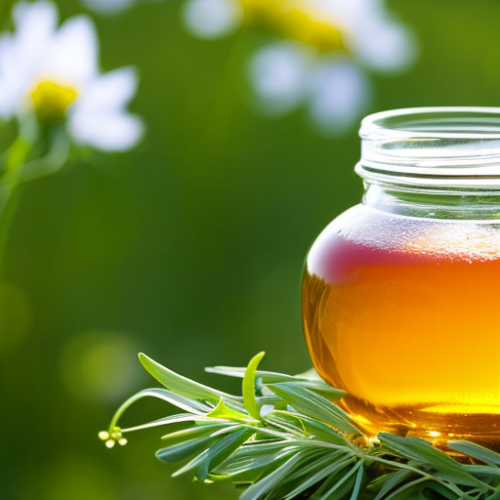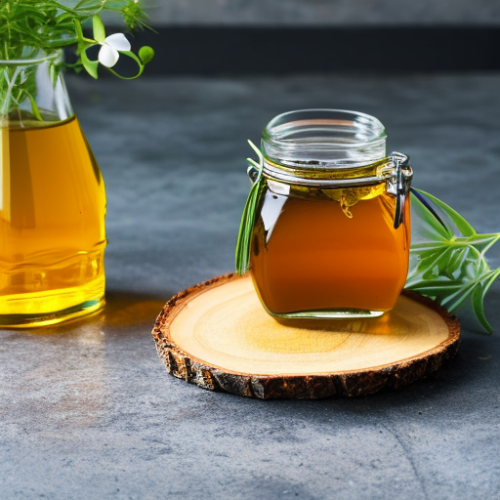Wildflower vs. Clover Honey: Know the Differences

You may love the taste of pure honey, but did you know that there are different types of honey that you can choose from? Two of the most popular kinds are wildflower honey and clover honey.
Inquiring minds want to know — what’s the difference between these two kinds of honey? We’re glad you asked!
Here we go over some of the main differences between wildflower honey vs clover honey. You’ll find out about the unique taste profiles of wildflower honey and clover honey, as well as the colors and possible health benefits of each! Oh so sweet, right?
{Affiliate links included below. As an Amazon Associate I earn from qualifying purchases.}
Difference #1: Wildflower honey is made from the nectar of many different flowers, while clover honey is made primarily from the nectar of red clover blossoms.

Wildflower honey is made from a variety of flowers as its name implies. This special type of honey is created when honey bees collect nectar from wild flowers such daisies or dandelions, or cultivated flowers like roses, lavender, cosmos, daisies and many more.
The main difference to keep in mind is that wildflower honey is a polyfloral honey. This means it comes from several flower varieties rather than just a single variety.
Wildflower honey is made by bees found in natural environments throughout the world. It’s also one of the most versatile and popular raw honey varieties in the United States!
In contrast to wildflower, clover honey is considered a monofloral honey. This means it’s derived almost solely from the nectar of just one (mono means “one”) flower: clover blossoms. White clover and crimson clover are the two main types of flowers used to make clover honey.
To make clover honey, bees visit clover plants and gather up the nectar from the clover flowers. They then take it back to the hive where it is transformed into tasty honey.
Clover is actually the most common type of honey today.
Another popular monofloral honey is buckwheat honey, which comes from (surprise!) buckwheat flowers.
Difference #2: The taste of wildflower honey is more complex and varied than that of clover honey, which has a milder, sweeter flavor.
If you’re seeking a bold flavor profile that’s more complex than regular clover honey, then wildflower honey should be your go-to!
With flavor notes that range from fruity to nutty–and even tangy–you never know what flavor profile will hit your taste buds with this honey.
Wildflower honey’s unique flavor is attributed to the specific nectar source from which the bees get their nectar.

The nectar from flowers such as mesquite, thistle, buckwheat and even Manuka found in New Zealand can all create the tantalizingly sweet taste of wildflower honey.
If you’ve ever tasted wildflower honey, you know how it can have a range of different flavors compared to clover honey’s milder and sweeter flavor.
Not only can you enjoy pure wildflower honey, you can also savor lesser known varieties. They all offer slightly different flavor profiles so you can expand your palate with each delightful spoonful.
With its bold, multifaceted notes, wildflower honey can add an extra layer of flavor to your food or beverage. It’s the perfect addition for marinades, glazes, salad dressings, hot beverages such as tea and coffee, and even desserts!
If you prefer honey with a mild taste, then clover honey is the best pick for you. They flavor may vary a little based on the type of clover, but in general, the taste of clover honeys is similar.
Clover honey’s more delicate and mild flavor pairs perfectly with oatmeal and biscuits or can be used in teas and cocktails for added sweetness.
Both raw honey types – wildflower and clover – are great spread on toast, stirred into yogurt and smoothies or used as a baking ingredient. (We love this recipe featuring raw honey).
A spoonful of either of these raw honeys will add the perfect note of sweetness to your favorite recipes!
Difference #3: Wildflower honey is darker in color than clover honey, which is typically light-colored or amber-hued.
It’s easy to spot the distinction in hue between wildflower and clover honeys; wildflower honey typically has a darker amber tone to it, while clover tends to be lighter in color with yellow or golden hues.
Wildflower honey is pure and delicious, a perfect addition to any pantry. It’s typically rich, dark hue catches the eye and delights the taste buds.
Wildflower honey stands in sharp contrast to the clover honey on store shelves. Clover is a light honey with a more mellow flavor.
Depending on the specific plant variety, clover honey can range in color from clear water white to light amber to amber.
Difference #4: Wildflower honey crystallizes more quickly than clover honey, due to its higher glucose content.
Wildflower honey is a special kind of nectar source for the vibrant honey you find in stores today. It is made from nectar collected from multiple blooming plants, giving it an overall richer flavor than other monofloral varieties like clover honey.
Another thing that makes wildflower honey unique is its higher glucose content. Because of this, it has a quicker crystallization process that’s noticeably faster than clover honey.
During nectar collection with bees, nectars from clover plants are generally easier for them to digest compared to nectar from other wildflowers. Because clover flowers contain lower amounts of glucose than wildflower nectar sources, wildflower honey may taste lighter or less sweet.
Crystallization is a normal feature of raw honey, and doesn’t mean your honey has gone bad. It just means your honey likely has a higher glucose content, and/or that it was exposed to cold temperatures at some point in transport or storage.
You can soften crystallized honey by gently heating the closed jar in a bowl or pan of hot (not boiling) water until the desire consistency is reached.

Difference #5: Clover honey is often used as a natural sweetener in foods and beverages, while wildflower honey can be used for both culinary and medicinal purposes.
If you need a replacement for sugar in drinks or something to sweeten up your food, both clover and wildflower can make a truly flavorful sweetener.
Many people like to use organic honey as a great alternative to regular table sugar — it’s much better for your body, and it will make whatever dish or drink it’s added to taste even better.
In addition to tasting great, raw honey provides its consumers with a plethora of health benefits.
Raw honey is packed with antioxidants and minerals, including calcium, iron, magnesium, potassium, sodium and zinc. It’s also rich in amino acids and vitamins such as B-complex and C.
Studies suggest that consuming two tablespoons of raw honey per day can reduce a person’s risk of developing certain diseases and illnesses, including heart disease, colon cancer, diabetes and stroke.
Additionally, raw honey has been shown to be an effective remedy for common ailments such as sore throats and coughs. It may even help with seasonal allergies!
Honey lozenges are wonderful for soothing dry and sore throats
Raw honey (particularly Manuka honey) is also known for medicinal benefits including antibacterial properties which can help fight infections and promote healing. It has anti-inflammatory properties that can help reduce swelling, redness and irritation in wounds or skin conditions.
Furthermore, raw honey contains prebiotics and probiotics which are beneficial bacteria that aid digestion, improve gut health, and boost the immune system.
So in addition to its naturally sweet taste, raw honey can have incredible health benefits! Raw honey contains compounds like bee pollen and various antioxidants, which are components that can help reduce free radicals in the body.
Ultimately, when thinking about health benefits, the choice between wildflower and clover honey is a matter of preference. Both are excellent sources of antioxidants, vitamins, minerals and enzymes and make great natural sweeteners.
Whether you choose wildflower or clover honey, remember to always opt for raw honey varieties to get its maximum health benefits. The kind of regular honey you get from the store is processed, which removes many of the health-promoting properties.
Frequently Asked Questions About Wildflower Honey vs. Clover Honey
What’s the difference between raw honey and processed honey?
Raw honey is a special kind of honey that has become increasingly popular mainly due to its many health benefits. It stands out from regular, processed honey for several reasons.
First, raw honey is unprocessed and straight from the hive. This means it contains all of its natural enzymes, vitamins, minerals and antioxidants which are essential for good health.
Raw honey is usually screened but not highly filtered. Health advocates usually agree that unfiltered honey is better.
In comparison, processed honey often goes through heating and filtering processes to improve taste and remove impurities, but this also removes many of the beneficial properties found in raw honey.
Another major difference between raw and processed honeys is their taste. Raw honeys have unique flavor profiles with floral undertones based on the flowers they come. Processed honeys will be more uniform in flavor due to the standardized processing method.
Additionally, raw honeys may contain bee pollen particles or even occasionally stray bee parts (like wings) while these parts are filtered and removed during the production process.
You can get both raw wildflower honey and raw clover honey online and at many farmers’ markets. It is considered the best tasting honey by many honey lovers.

Is organic honey better than non-organic honey?
Organic honey is the favorite of many honey connoisseurs due to both the robust flavor as well as the health benefits it provides. However, when compared to non-organic honey, what are the key differences and which one should you choose?
Organic honey is made from flowers that have not been treated with any pesticides or other chemicals. It contains more antioxidants, vitamins and minerals than non-organic honey and usually has a darker color.
Organic honey normally has a stronger flavor and aroma than non-organic varieties. In addition, organic production helps to protect bees from the hazards of pesticides used in conventional agriculture.
Non-organic honey can come from farms where chemical treatments are used on plants or where bees are exposed to antibiotics or other drugs. Non-organic honeys can be lighter in color and generally have milder flavors when compared with organic honeys.
If you haven’t tried organic wildflower honey, you’re in for a real treat!
—>>> How is your dental health? Take this quiz today to find out!
What are some other types of raw honey?
Acacia honey: Acacia honey is a unique and delicately sweet honey that has been around for centuries. This type of honey comes from the nectar of the acacia tree, which is part of the Fabaceae family of trees. It’s a popular ingredient in many desserts, drinks and traditional medicines due to its golden color and distinctive flavor.
Acacia honey boasts a mild taste compared to other varieties, making it an excellent choice for those with more sensitive palates. Its light floral notes also make it great for baking or used as a topping on your favorite fruits or breakfast cereals.
Not only does this honey have an amazing taste, but it contains several beneficial compounds like vitamins B1, B2, C and E as well as minerals such as calcium, magnesium and potassium!
Orange blossom honey: Orange blossom honey is another unique type of honey that is made from the nectar of orange blossoms.
It has a distinct flavor and aroma that make it popular among beekeepers and connoisseurs alike. Orange blossom honey has been used for centuries in cooking, baking, and even as an ingredient in cocktails!
This type of honey is known for its light golden color, mild citrusy taste, and heady floral aroma.
Beyond its delicious flavor and scent, orange blossom honey has some impressive health benefits too.
It’s packed with antioxidants that help reduce inflammation while providing the body with essential nutrients like vitamin C, potassium, magnesium, iron, zinc and more.
Plus it helps to boost immune systems and can even aid in digestion!
Tupelo honey: Tupelo honey is one of the most sought after types of honey in the United States.
The nectar for this particular type of honey comes from the white tupelo gum trees located in the southeastern part of the country such as Florida.
It has a unique flavor that sets it apart from other honeys; its taste is sweet, yet slightly tart and often compared to fruits like apples or pears.
It’s also known for having a milder sweetness than many other varieties, making it a great addition to both sweet and savory recipes.
Tupelo honey has plenty of health benefits due to its antioxidant content, which makes it great for boosting immunity and reducing inflammation.
For those looking to make healthier food choices, tupelo honey can be used as a natural sweetener instead of processed sugars.
Linden honey: Made from the nectar of lime or basswood trees, Linden honey has a unique floral aroma and taste that sets it apart from many other honeys.
It’s also thicker than regular honey, with a creamy texture and golden color that hints at the health benefits within.
As is the case with many other honeys, Linden honey can help soothe sore throats while helping to fight against viruses like colds and flus.
Lavender honey: Lavender honey is a unique form of honey with a distinct flavor unlike any other. Not only does it taste delicious, but it also has many health benefits associated with it.
This ancient medicinal remedy is gaining popularity due to its natural healing properties as well as its sweet, floral flavor.
Lavender honey comes from the nectar of lavender flowers that are harvested from bee hives which have been placed near lavender farms and gardens.
The bees collect the nectar and return to their hives where they turn the raw nectar into delicious, aromatic honey.
It can be used in tea or coffee for a soothing drink, added to your favorite recipes for an extra layer of flavor, or even eaten on its own!
Black locust tree honey: The black locust tree is native to the southeastern United States and grows in a variety of habitats, including forests and along roadsides.
Bees often collect nectar from its flowers to produce this special type of honey.
It has an intense flavor with notes of caramel, molasses and coffee which makes it perfect for baking or as an ingredient in specialty recipes.
In addition to its unique flavor, black locust tree honey also contains higher levels of beneficial compounds than many other types of honey, making it an excellent choice for those looking for something more nutritious than traditional honeys.
Final Thoughts on Wildflower vs Clover Honey
When it comes to choosing among the different kinds of honey, it really depends on what your needs and preferences are.
If you’re looking for a distinct taste and complex flavor, then wildflower honey would be the way to go.
On the other hand, if you’re looking for a milder honey that won’t crystallize too quickly, then clover would be the best honey for you.
Ultimately, the choice is yours depending on what kind of taste and texture you prefer. You might try a taste test with some of each type to see which one you like the most.
Hopefully this article has helped to provide more insight into the differences between wildflower honey and clover honey so that you can make an informed decision about which one will suit you best!









